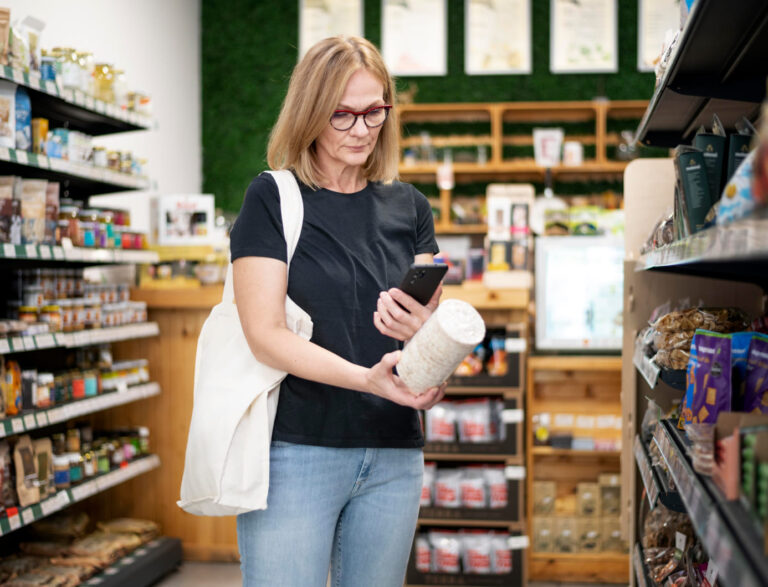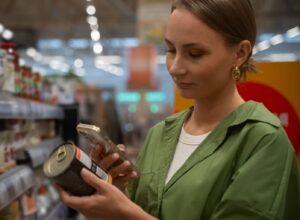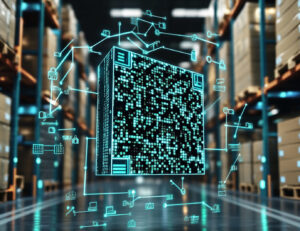Barcode technology has changed significantly over the last 50 years – and is entering a new stage. With its Digital Link, GS1 has introduced a new standard that will revolutionize the way we see barcodes and the information we can get from them. In this article, we will explore the benefits that GS1 2D barcodes bring to the retail industry, and how to use their full potential.
But first, let’s take a step back to see how far we have already come.
A very brief history of barcode technology
First came 1D barcodes. Also known as linear barcodes, these series of black-and-white bars encode limited amounts of data: a number or a short alphanumeric string. Over the years, different 1D formats evolved to suit different applications.
However, in the late 1980s, another type of barcode emerged: the 2D barcode. Unlike their 1D cousins, 2D barcodes store data horizontally and vertically, allowing them to encode far more information than traditional 1D barcodes. More capacious, they can contain various types of data, such as URLs, contact details, and product information, creating numerous new applications.
With the evolution of the different barcode types and symbologies came different requirements for reading them, resulting in a multitude of barcode reader types. Laser barcode scanners and Charge-Coupled Device (CCD) scanners both use a line of light that is reflected by the black-and-white bars of the barcode, and so can read only 1D barcodes.
2D barcodes, conversely, require camera-based scanners. Whether dedicated imager scanner or common smart device, they essentially take a picture of the barcode and use software to analyze and decode it. This makes them versatile tools that scan both 1D and 2D barcodes.
Yet, many industries still rely on old 1D barcode and scanner technology. Let’s take the UPC barcode, for instance. Created in the early 1970s, this 1D barcode is still used at the point-of-sale, scanned by fixed barcode scanners. Never change a running system – right?
Well, not quite. In this article, you will learn about the enormous potential that 2D barcodes bring to retail operations.
GS1 2D barcodes answer the need for high-capacity data carriers
Our digital age is marked by an ever-increasing demand for product information. Consumers want to make informed decisions, growing supply chains demand enhanced traceability, and compliance with regulations such as the EU’s Digital Product Passport (DPP) will require immense data tracking efforts from all parties involved in the manufacturing and distribution of products.
The GS1 Sunrise 2027 initiative answers this need for more information on product packaging. GS1 is a non-profit organization that provides global (barcode) standards used across all industries. It and 20+ industry-leading retailers and manufacturers have called for a switch from 1D to 2D product barcodes at the point-of-sale by the end of 2027.
GS1 standards focus on two 2D symbologies for this purpose: Data Matrix and QR Code.
But how will the retail industry benefit from moving to these barcodes?
The answer lies in the GS1 Digital Link. Encoded in a 2D barcode, the GS1 Digital Link enables access to different information depending on who scans it. While retail staff at the point-of-sale would receive classic POS information, a consumer scanning the barcode using their retail app would receive information on sourcing, nutritional information, and recipe ideas.
2D Digital Link barcodes thus don’t just provide more data capacity than the current UPC and EAN codes, they are also multifunctional. This benefits brand owners and all actors involved in the manufacturing and distribution of a product.
Implementation considerations for manufacturers and retailers
Undoubtedly, replacing all barcodes on product packaging – both 1D and 2D – with only one 2D barcode will take a considerable effort.
At the head of the supply chain, manufacturers will have to decide which of the approved 2D barcode types best serves their intentions. Then, they will have to ensure that their printing equipment can handle the higher precision required for 2D barcodes. Generally, this means switching from wet-ink to digital printing.
Retailers, meanwhile, have to ensure that their scanning equipment can handle 2D barcodes and the Digital Link at the point-of-sale, in-store, and in the warehouse. For this, modern barcode scanner software and an internet connection are required.
GS1 2D barcodes unlock new retail opportunities
However substantial the investment and process changes may be, using 2D barcodes at the point-of-sale and in retail operations opens up several benefits for retailers.
For one, this is because the barcodes can store individual product data, not just a product code. For another, the Digital Link enables cross-industry data sharing and access.
Here are some of the key opportunities:
- Keeping inventory levels accurate: Scanning 2D barcodes at the point of sale enables real-time stock level updates, improving the accuracy of inventory management systems. Meanwhile, that same barcode can be used for receiving, stocking, and stocktaking of products. Methods such as First In, First Out (FIFO) help avoid waste and keep products fresh.
- Enhancing traceability: 2D barcodes can include batch/lot numbers and serial numbers, allowing them to be used for tracking and tracing products along the supply chain. By giving customers access to this information, they are able to make informed decisions, enhancing trust.
- Improving product security: Improved traceability also enhances product safety. A product’s authenticity can be verified by accurately tracing a product’s origin, fighting counterfeits that are potentially dangerous to consumers and brand image alike. In case of recalls, the affected products are much easier to identify and track.
- Complying with sustainability regulations: Using 2D barcodes in retail operations is fundamental to compliance with regulations like the DPP. It also fosters sustainability efforts by giving consumers easy access to recycling and repair instructions.
- Fostering consumer engagement: Thanks to the Digital Link, 2D barcodes can give consumers access to enhanced information such as recipes, advertising, and nutritional information, enhancing engagement and improving consumer satisfaction.
- Clearer packaging design: Reducing all barcodes on packaging to one makes product design clearer. Now, employees and consumers don’t have to search for the barcode they are supposed to scan – instead, they quickly scan the only one.
Are you ready for the future?
Retailers have to ensure that they will be able to read 2D barcodes at the point-of-sale by the end of 2027. The earlier you start preparing for GS1 Sunrise 2027, the better. In many cases, this means replacing equipment.
Why not use the one-for-all approach for the barcode scanner as well? Mobile barcode scanners, such as smartphones, can scan 2D barcodes, and can read the Digital Link. Unlike fixed point-of-sale barcode scanners, they can be carried around, further enhancing flexibility. A retail employee stocking shelves could quickly take a customer payment or look up the availability of a product – all with the same device. All you need is reliable barcode scanner software.
The Scanbot Barcode Scanner SDK turns regular smart devices into powerful barcode scanners. It can scan all common 1D and 2D barcodes, even damaged ones and in bad lighting. With its ready-to-use UI components, you can easily and quickly build an intuitive user interface. Features such as Batch Scanning or Multi Scanning speed up a range of workflows.
Experience the Scanbot Barcode Scanner SDK for yourself by trying our free Barcode Scanner demo app – or by running our example apps for various platforms.
Or why not test the SDK directly in your app? Start integration immediately with a free 7-day trial license.



